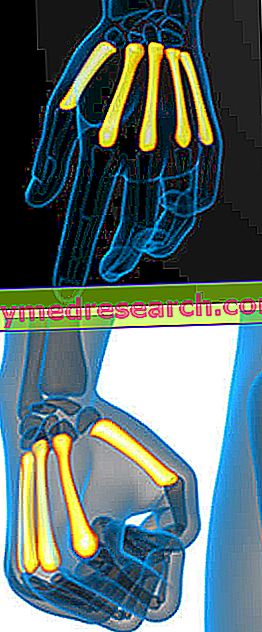Generality
A metacarpus, or metacarpal bone, is one of the 5 long bones that, in each hand, are placed between the carpal bones and the proximal phalanges of each finger (see figure).

The traditional name of the 5 metacarpi includes the use of the first 5 Roman numerals. From this it follows that: the I metacarpus is the metacarpal bone that precedes the phalanges of the thumb, the II metacarpus is the metacarpal bone that anticipates the phalanges of the index, the III metacarpus is the metacarpal bone placed before the phalanges of the medium and so on.
The pasterns are the insertion site for some important muscles and some ligaments of the hand.
Like any bone in the human skeleton, even the pasterns can suffer fractures.
What is a metacarpal?
A metacarpus, or metacarpal bone, is one of the 5 long bones that, in each hand, are positioned between the carpus - or the bony part constituting the wrist and the base of the hand - and the proximal phalanges (or first phalanges ) of each finger .
In a human hand, the pasterns are 5 bones of the total 27 (8 carpal bones, 5 metacarpal bones and 14 phalanges).
Review of the meaning of the terms proximal and distal
Proximal and distal are two terms with opposite meaning.
Proximal means "closer to the center of the body" or "closer to the point of origin". Referring to the femur, for example, it indicates the portion of this bone closest to the trunk.
Distal, on the other hand, means "farther from the center of the body" or "farther from the point of origin. Referred (always to the femur), for example, it indicates the portion of this bone furthest from the trunk (and closer to the knee joint).

Fig. Bones of the hand. The 8 carpal bones constitute a structure called carpus. The carpus takes part in the important articulation of the wrist. The 14 phalanges constitute the skeleton of the 5 fingers of each hand: except the thumb, which is the only finger formed by 2 phalanges, all the other fingers have 3 phalanges each. The phalanges closest to the pasterns are called the first phalanges (or proximal phalanges); starting from these, the following are called, respectively, second phalanges (or intermediate phalanges) and third phalanges (or distal phalanges) *. * NB: in the case of the thumb, the numbering ends with the second phalanxes.
In each metacarpal, three portions are distinguishable:
- A central portion, called body ;
- A portion at the proximal end, called the base ;
- A portion at the distal end, called the head .
Between the so-called base and the so-called head, the body of each metacarpus is a cylindrical and elongated portion, with the important task of inserting it into the so-called interosseous muscles of the hand.
The base of each metacarpal is the slightly lumpy, bordering portion forming a joint with a carpus bone (or carpal bone). In the human being's hand, the various metacarpals border on different carpal bones, depending on the position occupied.
Finally, the head of each metacarpal is also the moderately lumpy portion, connected and articulated to a very specific proximal phalanx of the fingers. From this, it follows that each first phalanx of the hands is preceded by a precise metacarpal.
By convention, the 5 metacarpals are indicated with the first 5 Roman numerals, namely I (first), II (second), III, IV and V. The metacarpus reported with the number I ( I metacarpus ) is the metacarpal bone that precedes the proximal phalanx of the thumb ; the metacarpus indicated with the number II ( II metacarpus ) is the metacarpal bone preceding the proximal phalanx of the index finger ; the metacarpus reported with the number III ( metacarpus III ) is the metacarpal bone preceding the first phalanx of the middle finger ; the metacarpus identified with the number IV ( IV metacarpus ) is the metacarpal bone preceding the proximal phalanx of the ring finger ; finally, the metacarpus indicated with the number V ( V metacarpus ) is the metacarpal bone that precedes the first phalanx of the little finger .
Also by convection, the metacarpus considered more lateral is the I metacarpus (that of the thumb), while the metacarpus considered more medial is the V metacarpus (that of the little finger).
With which carpal bones do the metacarpins confine?
The carpus of the hand includes 8 bones, which are: the scaphoid, the lunate, the triquatum, the pisiform, the trapezoid, the trapezoid, the capitate and the hooked bone .
Of these newly mentioned bone elements, those that border the metacarpals are the last 4, that is: trapezoid, trapezoid, capitate and hooked. To be precise:
- The trapezoid borders on the I metacarpus;
- The trapezoid makes contact with the II metacarpal;
- The capitate is at the base of the third metacarpal;
- The hamate is articulated with the IV metacarpal and the V metacarpus.
ARTICULATIONS: SUMMARY AND NAME
As anticipated, each metacarpus is the protagonist of two joints : an articulation that involves the metacarpal portion called base and a carpal bone, and a joint that involves the metacarpal portion called head and the first phalanx of a finger.
The joints between the metacarpal bases and the carpal bones are called carpometacarpal joints, while the joints between the metacarpal heads and the proximal phalanges of each finger are called metacarpophalangeal joints .
LIGAMENTS
A ligament is a formation of fibrous connective tissue, which connects two bones or two parts of the same bone.
The ligaments that have relationships with the metacarpals are:
- The carpometacarpal ligaments, which run between the carpal bones and the metacarpals;
- The intermetacarpal ligaments, which involve the various metacarpals. There are 3 sub-types of intermetacarpal ligaments: interosseous, palmar and dorsal.
- The piso-metacarpal ligament, which, in each hand, involves the pisiform carpal bone and the V metatarsus.
MUSCLES
On the pasterns different muscles of the hand are inserted:
- The already mentioned interosseous muscles. Divided into dorsal and volary, the interosseous muscles fall between the intrinsic muscles of the hand and find insertion in the bodies of the metacarpals;
- Short radial extensor of the carpus. It is the main extender of the wrist; it is inserted at the base of the third metacarpal.
- Long radial extensor of the carpus. It's another extender of the wrist; it is inserted at the base of the II metacarpal.
- Carpal ulnar extensor. He is the third and last extender of the wrist; ends at the base of the V metacarpus.
- Long thumb abductor. It contributes to the extension of the thumb and ends at the base of the metacarpus corresponding to this finger of the hand.
- Carpal radial flexor. It is the main flexor of the wrist; it is inserted at the base of the third metacarpal.
- Ulnar carpus flexor. It's another flexor of the wrist; ends at the base of the V metacarpus.
Functions
By contributing to the formation of the skeleton of the hand and hosting important muscular elements, the complex of metacarpi is fundamental to the correct functionality of the hands.
In the human being, the hands make it possible to grasp objects, act as tactile organs, are communication tools and guarantee stability to the movement, at an early age.
clinic
Like all bones in the human body, the pasterns can also be subject to fractures .
In most cases, the fractures of the metacarpal bones concern the metacarpal I - specifically, the base of the metacarpal I - and the V metacarpal - to be precise, the region that precedes the head and which the anatomists call the neck.
Given the enormous spread of these two types of fractures, the doctors considered it appropriate to give them an identifying name, namely: Bennett's fracture, due to the fracture at the base of the I metacarpus, and boxer's fracture, due to the fracture of the neck of the V metacarpal.
- Bennett's fracture is generally following a thumb hyperabduction and often involves the carpal-metacarpal joint of the thumb.
- The break of the boxer is an injury that, above all, captures those who punch against objects of a certain resistance (eg, boxers).
An X-ray examination of the hand is essential for an accurate diagnosis of a metacarpal fracture after physical examination.
Treatment of a metacarpal fracture depends on the severity of the injury.
In fact, in the presence of stable and not particularly serious fractures, doctors opt for the application, on the patient's hand, of a pinstriped splint, to be held in position for about 2-3 weeks. In the presence of stable and severe fractures, the cast of the affected hand is expected for at least 4-6 weeks. Finally, in the presence of an unstable fracture, the therapy chosen by the doctors is surgical and consists of an operation aimed at the union, by means of screws, of the separated portions of the metacarpus.



